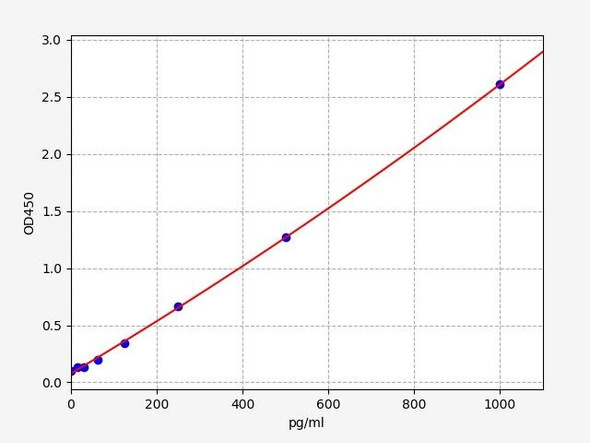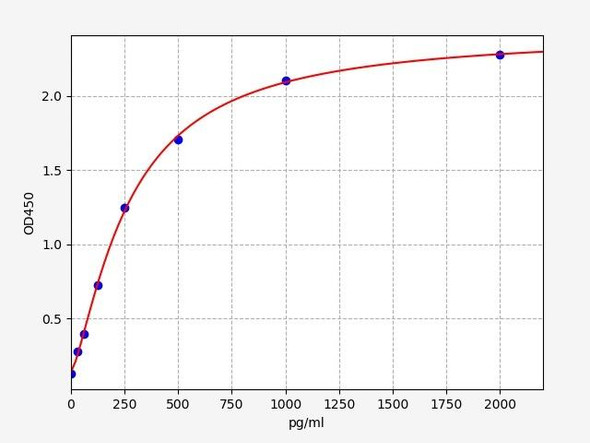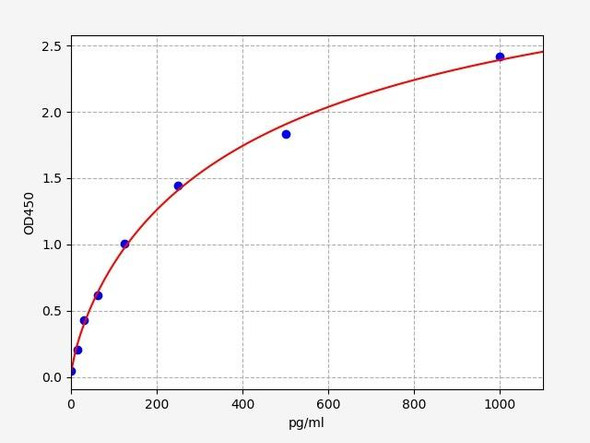Description
| Product Name: | Human RANTES / CCL5 ELISA Kit |
| Product Code: | HUFI00231 |
| Size: | 96 Assays |
| Alias: | Rantes, Regulated On Activation, Normal T-Cell Expressed and Secreted, CCL5, SCYA5, SISd |
| Detection method: | Sandwich ELISA, Double Antibody |
| Application: | This immunoassay kit allows for the in vitro quantitative determination of Human Rantes concentrations in serum plasma and other biological fluids. |
| Sensitivity: | 18.75pg/ml |
| Range: | 31.25-2000pg/ml |
| Storage: | 4°C for 6 months |
| Note: | For Research Use Only |
| Recovery: | Matrices listed below were spiked with certain level of Human Rantes and the recovery rates were calculated by comparing the measured value to the expected amount of Human Rantes in samples. | ||||||||||||||||
| |||||||||||||||||
| Linearity: | The linearity of the kit was assayed by testing samples spiked with appropriate concentration of Human Rantes and their serial dilutions. The results were demonstrated by the percentage of calculated concentration to the expected. | ||||||||||||||||
| |||||||||||||||||
| CV(%): | Intra-Assay: CV<8% Inter-Assay: CV<10% |
| Component | Quantity | Storage |
| ELISA Microplate (Dismountable) | 8×12 strips | 4°C for 6 months |
| Lyophilized Standard | 2 | 4°C/-20°C |
| Sample/Standard Dilution Buffer | 20ml | 4°C |
| Biotin-labeled Antibody(Concentrated) | 120ul | 4°C (Protect from light) |
| Antibody Dilution Buffer | 10ml | 4°C |
| HRP-Streptavidin Conjugate(SABC) | 120ul | 4°C (Protect from light) |
| SABC Dilution Buffer | 10ml | 4°C |
| TMB Substrate | 10ml | 4°C (Protect from light) |
| Stop Solution | 10ml | 4°C |
| Wash Buffer(25X) | 30ml | 4°C |
| Plate Sealer | 5 | - |
Other materials and equipment required:
- Microplate reader with 450 nm wavelength filter
- Multichannel Pipette, Pipette, microcentrifuge tubes and disposable pipette tips
- Incubator
- Deionized or distilled water
- Absorbent paper
- Buffer resevoir
| Uniprot | P13501 |
| UniProt Protein Function: | CCL5: Chemoattractant for blood monocytes, memory T-helper cells and eosinophils. Causes the release of histamine from basophils and activates eosinophils. Binds to CCR1, CCR3, CCR4 and CCR5. One of the major HIV-suppressive factors produced by CD8+ T- cells. Recombinant RANTES protein induces a dose-dependent inhibition of different strains of HIV-1, HIV-2, and simian immunodeficiency virus (SIV). The processed form RANTES(3-68) acts as a natural chemotaxis inhibitor and is a more potent inhibitor of HIV-1-infection. The second processed form RANTES(4-68) exhibits reduced chemotactic and HIV-suppressive activity compared with RANTES(1-68) and RANTES(3-68) and is generated by an unidentified enzyme associated with monocytes and neutrophils. By mitogens. T-cell and macrophage specific. Belongs to the intercrine beta (chemokine CC) family. |
| UniProt Protein Details: | Protein type:Chemokine; Secreted; Cell adhesion; Motility/polarity/chemotaxis; Secreted, signal peptide Chromosomal Location of Human Ortholog: 17q12 Cellular Component: extracellular space; cytoplasm; extracellular region Molecular Function:protein homodimerization activity; protein self-association; receptor signaling protein tyrosine kinase activator activity; phosphoinositide phospholipase C activity; protein kinase activity; protein binding; CCR1 chemokine receptor binding; CCR4 chemokine receptor binding; chemokine receptor binding; chemokine activity; chemokine receptor antagonist activity; phospholipase activator activity; CCR5 chemokine receptor binding; chemoattractant activity Biological Process: regulation of chronic inflammatory response; exocytosis; positive regulation of cell adhesion; response to toxin; positive regulation of smooth muscle cell proliferation; positive regulation of JAK-STAT cascade; positive regulation of smooth muscle cell migration; chemotaxis; positive regulation of cell-cell adhesion mediated by integrin; protein amino acid phosphorylation; positive regulation of homotypic cell-cell adhesion; positive regulation of translational initiation; monocyte chemotaxis; leukocyte adhesion; cell-cell signaling; positive chemotaxis; calcium ion transport; positive regulation of innate immune response; protein kinase B signaling cascade; lipopolysaccharide-mediated signaling pathway; dendritic cell chemotaxis; positive regulation of T cell proliferation; inflammatory response; protein tetramerization; phospholipase D activation; positive regulation of viral genome replication; neutrophil activation; negative regulation of G-protein coupled receptor protein signaling pathway; response to virus; MAPKKK cascade; positive regulation of cellular biosynthetic process; macrophage chemotaxis; cellular calcium ion homeostasis; positive regulation of phosphoinositide 3-kinase cascade; G-protein coupled receptor protein signaling pathway; cellular protein complex assembly; positive regulation of tyrosine phosphorylation of STAT protein; negative regulation of viral genome replication; eosinophil chemotaxis; positive regulation of calcium ion transport; regulation of insulin secretion; positive regulation of epithelial cell proliferation; positive regulation of phosphorylation; positive regulation of cell migration; regulation of T cell activation |
| NCBI Summary: | This gene is one of several chemokine genes clustered on the q-arm of chromosome 17. Chemokines form a superfamily of secreted proteins involved in immunoregulatory and inflammatory processes. The superfamily is divided into four subfamilies based on the arrangement of the N-terminal cysteine residues of the mature peptide. This chemokine, a member of the CC subfamily, functions as a chemoattractant for blood monocytes, memory T helper cells and eosinophils. It causes the release of histamine from basophils and activates eosinophils. This cytokine is one of the major HIV-suppressive factors produced by CD8+ cells. It functions as one of the natural ligands for the chemokine receptor chemokine (C-C motif) receptor 5 (CCR5), and it suppresses in vitro replication of the R5 strains of HIV-1, which use CCR5 as a coreceptor. Alternative splicing results in multiple transcript variants that encode different isoforms. [provided by RefSeq, Jul 2013] |
| UniProt Code: | P13501 |
| NCBI GenInfo Identifier: | 6175077 |
| NCBI Gene ID: | 6352 |
| NCBI Accession: | P13501.3 |
| UniProt Secondary Accession: | P13501,O43646, Q0QVW8, Q4ZGJ1, Q9NYA2, Q9UBG2, Q9UC99 |
| UniProt Related Accession: | P13501 |
| Molecular Weight: | 91 |
| NCBI Full Name: | C-C motif chemokine 5 |
| NCBI Synonym Full Names: | chemokine (C-C motif) ligand 5 |
| NCBI Official Symbol: | CCL5 |
| NCBI Official Synonym Symbols: | SISd; eoCP; SCYA5; RANTES; TCP228; D17S136E; SIS-delta |
| NCBI Protein Information: | C-C motif chemokine 5; beta-chemokine RANTES; T-cell specific protein p288; eosinophil chemotactic cytokine; small inducible cytokine subfamily A (Cys-Cys), member 5; regulated upon activation, normally T-expressed, and presumably secreted |
| UniProt Protein Name: | C-C motif chemokine 5 |
| UniProt Synonym Protein Names: | EoCP; Eosinophil chemotactic cytokine; SIS-delta; Small-inducible cytokine A5; T cell-specific protein P228; TCP228; T-cell-specific protein RANTESCleaved into the following 2 chains:RANTES(3-68); RANTES(4-68) |
| Protein Family: | C-C motif chemokine |
| UniProt Gene Name: | CCL5 |
| UniProt Entry Name: | CCL5_HUMAN |
*Note: Protocols are specific to each batch/lot. For the correct instructions please follow the protocol included in your kit.
Before adding to wells, equilibrate the SABC working solution and TMB substrate for at least 30 min at 37°C. When diluting samples and reagents, they must be mixed completely and evenly. It is recommended to plot a standard curve for each test.
| Step | Protocol |
| 1. | Set standard, test sample and control (zero) wells on the pre-coated plate respectively, and then, record their positions. It is recommended to measure each standard and sample in duplicate. Wash plate 2 times before adding standard, sample and control (zero) wells! |
| 2. | Aliquot 0.1ml standard solutions into the standard wells. |
| 3. | Add 0.1 ml of Sample / Standard dilution buffer into the control (zero) well. |
| 4. | Add 0.1 ml of properly diluted sample ( Human serum, plasma, tissue homogenates and other biological fluids.) into test sample wells. |
| 5. | Seal the plate with a cover and incubate at 37 °C for 90 min. |
| 6. | Remove the cover and discard the plate content, clap the plate on the absorbent filter papers or other absorbent material. Do NOT let the wells completely dry at any time. Wash plate X2. |
| 7. | Add 0.1 ml of Biotin- detection antibody working solution into the above wells (standard, test sample & zero wells). Add the solution at the bottom of each well without touching the side wall. |
| 8. | Seal the plate with a cover and incubate at 37°C for 60 min. |
| 9. | Remove the cover, and wash plate 3 times with Wash buffer. Let wash buffer rest in wells for 1 min between each wash. |
| 10. | Add 0.1 ml of SABC working solution into each well, cover the plate and incubate at 37°C for 30 min. |
| 11. | Remove the cover and wash plate 5 times with Wash buffer, and each time let the wash buffer stay in the wells for 1-2 min. |
| 12. | Add 90 µl of TMB substrate into each well, cover the plate and incubate at 37°C in dark within 10-20 min. (Note: This incubation time is for reference use only, the optimal time should be determined by end user.) And the shades of blue can be seen in the first 3-4 wells (with most concentrated standard solutions), the other wells show no obvious color. |
| 13. | Add 50 µl of Stop solution into each well and mix thoroughly. The color changes into yellow immediately. |
| 14. | Read the O.D. absorbance at 450 nm in a microplate reader immediately after adding the stop solution. |
When carrying out an ELISA assay it is important to prepare your samples in order to achieve the best possible results. Below we have a list of procedures for the preparation of samples for different sample types.
| Sample Type | Protocol |
| Serum | If using serum separator tubes, allow samples to clot for 30 minutes at room temperature. Centrifuge for 10 minutes at 1,000x g. Collect the serum fraction and assay promptly or aliquot and store the samples at -80°C. Avoid multiple freeze-thaw cycles. If serum separator tubes are not being used, allow samples to clot overnight at 2-8°C. Centrifuge for 10 minutes at 1,000x g. Remove serum and assay promptly or aliquot and store the samples at -80°C. Avoid multiple freeze-thaw cycles. |
| Plasma | Collect plasma using EDTA or heparin as an anticoagulant. Centrifuge samples at 4°C for 15 mins at 1000 × g within 30 mins of collection. Collect the plasma fraction and assay promptly or aliquot and store the samples at -80°C. Avoid multiple freeze-thaw cycles. Note: Over haemolysed samples are not suitable for use with this kit. |
| Urine & Cerebrospinal Fluid | Collect the urine (mid-stream) in a sterile container, centrifuge for 20 mins at 2000-3000 rpm. Remove supernatant and assay immediately. If any precipitation is detected, repeat the centrifugation step. A similar protocol can be used for cerebrospinal fluid. |
| Cell culture supernatant | Collect the cell culture media by pipette, followed by centrifugation at 4°C for 20 mins at 1500 rpm. Collect the clear supernatant and assay immediately. |
| Cell lysates | Solubilize cells in lysis buffer and allow to sit on ice for 30 minutes. Centrifuge tubes at 14,000 x g for 5 minutes to remove insoluble material. Aliquot the supernatant into a new tube and discard the remaining whole cell extract. Quantify total protein concentration using a total protein assay. Assay immediately or aliquot and store at ≤ -20 °C. |
| Tissue homogenates | The preparation of tissue homogenates will vary depending upon tissue type. Rinse tissue with 1X PBS to remove excess blood & homogenize in 20ml of 1X PBS (including protease inhibitors) and store overnight at ≤ -20°C. Two freeze-thaw cycles are required to break the cell membranes. To further disrupt the cell membranes you can sonicate the samples. Centrifuge homogenates for 5 mins at 5000xg. Remove the supernatant and assay immediately or aliquot and store at -20°C or -80°C. |
| Tissue lysates | Rinse tissue with PBS, cut into 1-2 mm pieces, and homogenize with a tissue homogenizer in PBS. Add an equal volume of RIPA buffer containing protease inhibitors and lyse tissues at room temperature for 30 minutes with gentle agitation. Centrifuge to remove debris. Quantify total protein concentration using a total protein assay. Assay immediately or aliquot and store at ≤ -20 °C. |
| Breast Milk | Collect milk samples and centrifuge at 10,000 x g for 60 min at 4°C. Aliquot the supernatant and assay. For long term use, store samples at -80°C. Minimize freeze/thaw cycles. |
| Ang et al. | Chimeric Oncolytic Adenovirus Armed Chemokine Rantes for Treatment of Breast Cancer | Bioengineering 2022 | PubMed ID: 35892755 |
Fill out our quote form below and a dedicated member of staff will get back to you within one working day!






